#some of it is wool yarn based and some of it is wool fluff used like a fur (but threaded into the textile base instead of on skin)
Explore tagged Tumblr posts
Text
i like wool a normal amount says person with room full of wool yarn, wool hats, wool sweaters, wool blazers, wool blankets, wool cushions, wool slippers, and wool scarves and who likes wool a little more than a normal amount
#rubia speaks#wool#some of it is wool yarn based and some of it is wool fluff used like a fur (but threaded into the textile base instead of on skin)
8 notes
·
View notes
Text


Oo..el bobito
progress photos + notes 👇🏻 I was going to put a read more but it just kept messing up the order of images soooo um. 👍🏻
I started out by doing tiny concept sketches of what I wanted my guy to look like, and some rough ideas of potential proportions. From these I picked one, scanned it and printed it out to-scale (23cm head to toe), and used it as a guide when making my patterns and constructing the body.
Each leg has a little pebble in it to weigh it down, as well as the torso :)

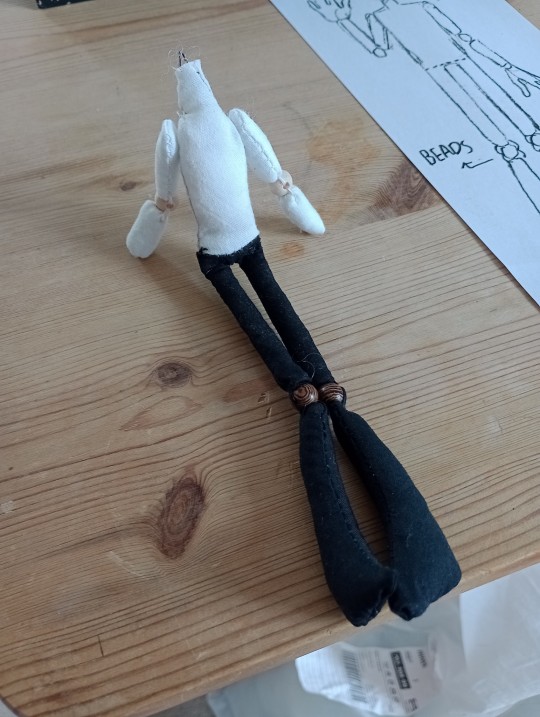
After, I made some hands out of Epoxy sculpt. I refined and sanded them twice (once when they were half-dry, and then again the morning after) before giving them a couple coats of paint and blushing them with oil pastels and a brush. I put a little hole in each of them so that I could sew them onto the arms later.
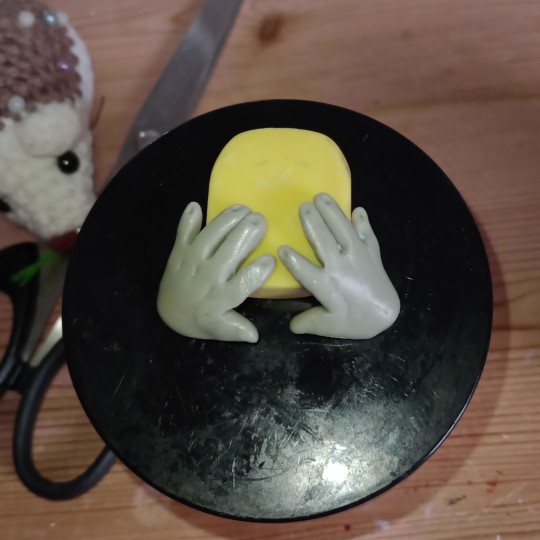
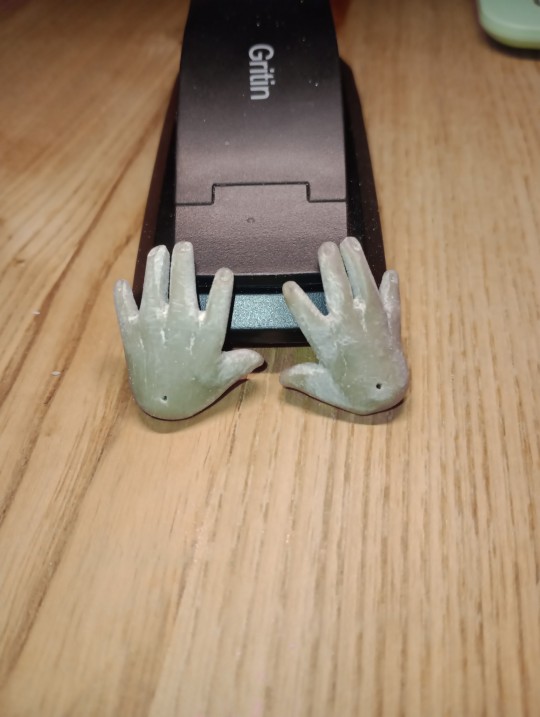
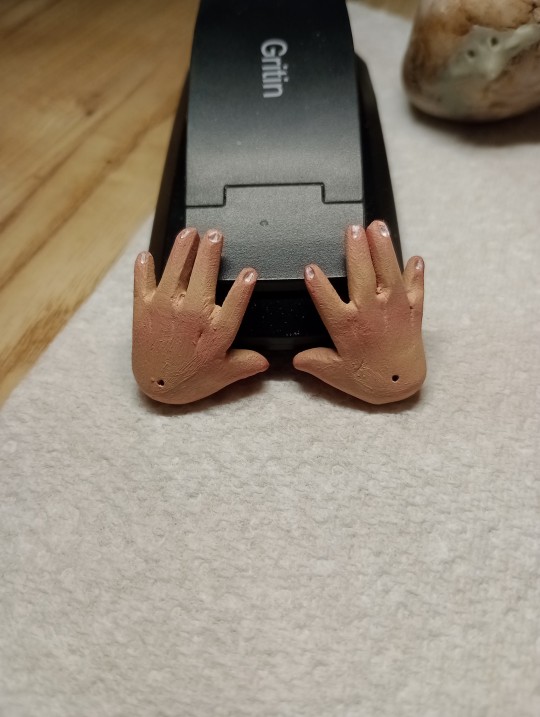
I didn't take any progress shots of the jacket, but I basically eyeballed it and drew out some patterns I thought looked right and cut them out of some scraps from an old cosplay. Since I was working on such a small scale, I chose to glue the seams together and dab a thin line of fabric glue along the raw edges to prevent fraying. The buttons are made of small beads glued to the front.
After sewing the hands on, I began work on the head.
I started by feeding a folded pipe cleaner down the spine of the torso, leaving a length poking out of the top to be stuck through the head as support. I crocheted the base and pulled the pipe cleaner through it before stuffing + closing it, and then folded the wire into the head to stop it from slipping out.
The felting took me a few tries; I couldn't find the right wool colour at first, so after a while I decided to fluff up some of the same yarn I used to crochet the head and use that instead. A few hours of felting later, a little bit of black wool for the eyes and mouth, and it was ready to be blushed with pastels like the hands ^_^
The hair I rooted strand by strand, using small pieces of brown yarn split into 3 strands each and rooted using my felting needle. I worked in an inward spiral, and then filled out any thin areas with the leftover yarn.
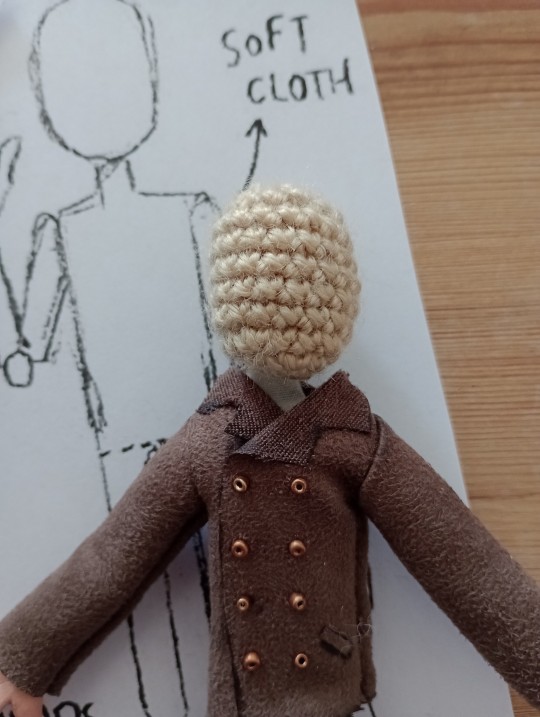

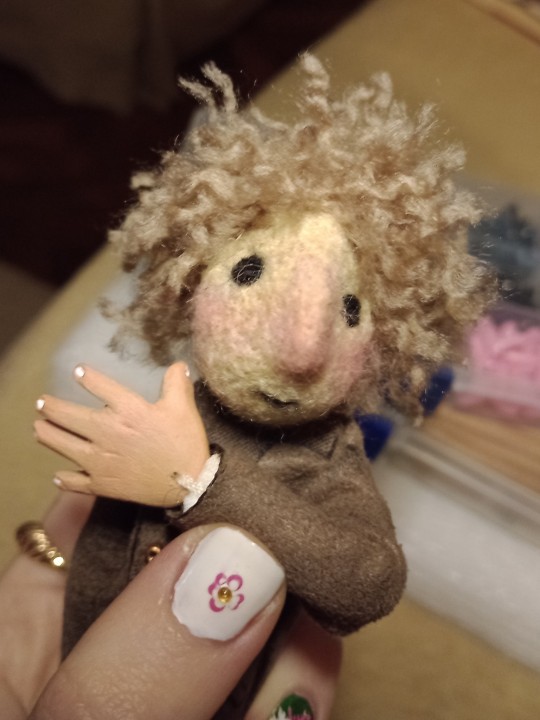
Thus was born el bobito <3
108 notes
·
View notes
Note
Kinda random, but can you do the papas/ghouls with a sibling of sin who crochets (preferably nonrimantic/platonic relationship but you don’t have to) also hope you have a good day/week :)
Never be afraid to ask for platonic/friendship/non-romantic requests! I’m always happy to do them :)
Also, crocheting is the BEST! I’m so excited to do this!
I hope you enjoy and have a good night yourself ❤️
G/N Reader
Platonic friendship
Era V Ghouls
Fluff/light hearted prompt
Papas and Ghouls with a Sibling of Sin who Crochets
Papa Nihil: One of his most prized possessions is a vintage styled blanket you made for him. It’s a granny square blanket with trim, and in the warm colors you’d find in someone’s 70’s inspired house. It reminds him of the ones he used to love and it stays on the back of his couch. You have been roped into being his movie buddy. So while you both are watching cheesy horror movies, you share the blanket as he watches and you crochet more!
Papa I: Papa adores your crocheting! Most of your time spent together is basically you both doing a quiet activity while lightly chatting. You with your yarn and he with whatever task he’s appointed himself that day. He has commissioned you for pot cozies for his favorite old plants. They comically break up his dark decor, but he adores them. You even picked a yarn that feels good sensory wise on his hands! Whenever he finds old books about yarn and needlework he gives them to you. It actually got you into lace making as well!
Papa II: He has a reputation for being a luxury goods type of man, and many wrongly assume he wouldn’t like hand made goods. But Papa has a deep respect for any skill based craft. Depending on what you make may or may not interest him, but he admires your skill. You once crocheted him some very tasteful doilies. Papa uses them under his favorite bottles of alcohol to really bring out his display shelves. He has gifted you high quality wool yarn before.
Papa III: Acts like everything you make is divine. Because to him it is! Papa also has a deep love of craftsmanship. But be aware, he LOVES getting hand made things from you! Papa will happily commission you for whatever pops into his head. Or if you’re making something he will go, “I want one too! Make it in purple?” Papa delights in being a friend and patron of you, no matter what you make. His favorite is the time you made him a sweater for his birthday! He wore it all day and bragged about having a one of kind piece of art from you.
Papa IV/Cardinal Copia: Copia tends to get lost in watching you crochet. Like, he intensely watches your hands as you work. He can’t help himself, it’s so mesmerizing! He won’t admit how much he really wants stuff you’ve made. But Copia knows from experience how annoying it is to be pestered for your skill. He’s absolutely delighted when you make him a toy rat! It stays in his office on his desk so he can play with it while he’s thinking.
Aether: You convinced him to take up crocheting with you… and he LOVES IT! It’s actually thanks to you both that the band had those gold sweaters for the Christmas pictures back in the Prequelle days! You two had worked your fingers to the bone for MONTHS to get them ready! Aether finds a similar peace in crocheting the way he does with guitar. When he stayed back from touring he had more time to dedicate working with you. You even have your own sweater he made just for you!
Phantom: You have this chaotic ghoul so enamored with everything you make!! You even made him a tiny yarn ghost that he takes everywhere (affectionately named Phantom Jr.) you have tried to help teach Phantom how to knit with very little success. Oh well! He’ll just sit and watch you do it instead. Phantom always has questions and is just happy to hear you talk about it! Phantom Jr is placed in his front vest pocket at all times.
Aurora: Constantly begs you to go yarn shopping with her. Aurora actually has a brilliant eye for color and flair, so she happily picks out combinations to use for your projects. She became addicted to your work when you made her a pair of fingerless gloves so her prized claws don’t get caught. She introduced you to the rest of the band as, “my amazingly talented friend who made the gloves you’re all jealous of”!
Sunshine: Thinks you’re some kind of wizard, because how else could you do something so amazing?? Sunshine loves to sit with you and hold your yarn as you work. Sometimes they like to help and just untangle your yarn or re-wind some back into skeins. Sunshine is just happy to watch you make amazing pieces while they practice or do boring paper work next to you. They won’t admit they would love a fun hat from you!
Swiss: Has worn everything you ever made him and immediately shows them off. Swiss has mastered doing a fashion show walk as he models the newest hat you made. “Oh, is everyone jealous I have the newest crochet couture?” If you sell these he will tell EVERYONE! Thanks to him the whole band owns one of your hats!! He’s so proud of your skill and vows to get everyone in the ministry to adore your work!
Cumulus: You both accidentally became good friends thanks to your crocheting! You were taking commissions around the ministry to earn a few extra dollars and favors (as chores only gave you so much allowance). Imagine your surprised when THE Cumulus approached you with a want for a scarf. You ended up knitting the most gorgeous bean stitch cream scarf for her. While chatting during the commission times you both found you got along splendidly. Cumulus hasn’t let you out of her sight since, and wears her scarf every winter!
Cirrus: The pianist has made it her mission to stop others from pestering you for free crochet pieces. Specifically her fellow band mates. But Cirrus won’t lie and say she has a lot of pride in being able to say she owns one of your little crochet animals. You once made her a tiny yarn cat just because, and she adores it! When you both are hanging around you nearly cried seeing the little plush cat rest on her practice keyboard. According to Cirrus, that’s her song editor. Awww!
Mountain: You weren’t sure what he thought of, he’s always so quiet! You were surprised one day when he finally seemed to acknowledge your hobby by politely showing you a pattern. A yarn cactus plushie attached to a plush pot. Mountain explains he really wanted to see if you would make him something but felt too shy to ask. The drummer assuming that you made so many projects because you’re obviously swarmed by commissions! He was so grateful you made it and praises you for how well made it is. You were so flattered when he immediately showed the rest of the band what you made!
Rain: Adores anything cute you make! His favorite are the little animals you make from different patterns. Every time you find a new pattern he asks if you can make him one too! He has a whole shelf of small yarn animals and refuses to let anyone touch them. They are special because they are from you, one of his best friends! He especially adores the jellyfish with long yarn trails you made for his summoning anniversary.
Sodo/Ember: Thinks crocheting is badass but it’s a little low energy for him. He can’t watch you do it or it calms him down enough to want to take a nap (everyone begs you to keep doing it.) if you crochet around him and he’s tired enough he will just rest on you and sleep (with permission of course.) you have made him a hat to cover the time he broke his horn and Sodo refused to let anyone touch it. He has commissioned you to make gifts for the band many times!
#the band ghost#ghost headcanons#ghost bc#ghost fluff#ghost reader insert#ghost reader#papa nihil#papa emeritus i#papa emeritus iii#cardinal copia#papa emeritus ii#papa emeritus iv#platonic reader#friendship#reader insert#nameless ghouls#era v#Aether#phantom#cirrus#cumulus#aurora#swiss#sunshine#sodo#ember#rain#mountain
59 notes
·
View notes
Text
Junk as Art & Craft Material
Suffer from hoards of junk from your dungeon
Realize you despise each and every one of them
Stop, before you burn them with heck fire, and think
Can I use any of them as materials, and turn them into something less despicable?
Bonus points for combining more than one junk into new art
If yes, profit! You shall art and craft with free materials!
If you ever stumble upon this post, please tell me about trash you creatively used for art that you thought was so clever you want to tell everyone about it (I want to hear it).
Mine are:
Packaging closed cell-foam blocks as needlefelting base
Using all sorts of fiber for needlefelting, my cut hair, my cat’s hair, my mom’s and aunt’s dog hair, unraveled yarn wool, unraveled wool from felted phone case for a long-gone dumb phone, and my most proud one was poly-liners from grocery deliveries from the panini era (absolutely atrocious and opulent one-use material cause poly-fluff isn’t even cheap from crafts stores)
Random plastic pieces incorporated as parts for my projects like little red heart tabs from bubble tea bottles as ears, salvaged plastic flower stems for my strange flower. Colored plastics and plastics in interesting pre-mold shapes are my preferred junk.
Using junk doesn’t mean the end result ought to be flimsy either. It really depends on your choice of junk and how they are used. I recommend paying attention to the material of choice, and recall / visualize how they behave from your own experience. Some plastics are more brittle and UV susceptible than others, and I avoid those.
I also used to scoff at plastics and prefer biodegradable materials. Then I had a brain thought on: if the junk biodegrades, they don’t really need saving (unless they’re really interesting). So it seems sensible to incorporate non-biodegradable junk in my projects.
Downside (sort of) is, sometimes one of these creative use of junk becomes a preferred method of doing things and you either have to loot your friends and family’s dungeons or buy more for your future project.
But I am grateful for the original junk that gave me these crafting ideas out of necessity, and implore everyone to really reimagine your trash as art and craft materials. This practice opened my mind about how strongly my preconceptions can be about inanimate objects sometimes due to frustration, sometimes due to environmental / context associations.
Every object can be deconstructed, some are useful for your work while some may not be. Your choice of material can be your inspiration. I am no master at this, but when a piece of “junk” clicks with my project seamlessly, it’s like the stars aligned and I discovered a secret thing that was meant to be. As if the Muses say: hey, here is a great piece of guilt-free money-free material for this exact project you will want to make.
It’s a blessed thing. Junk.
#art tips#art chatter#random thoughts#upcycling#upcycled#upcycle#recycling#trash art#mending#zero waste#crafts#crafting#arts and crafts#trash bash#scrap build
25 notes
·
View notes
Text

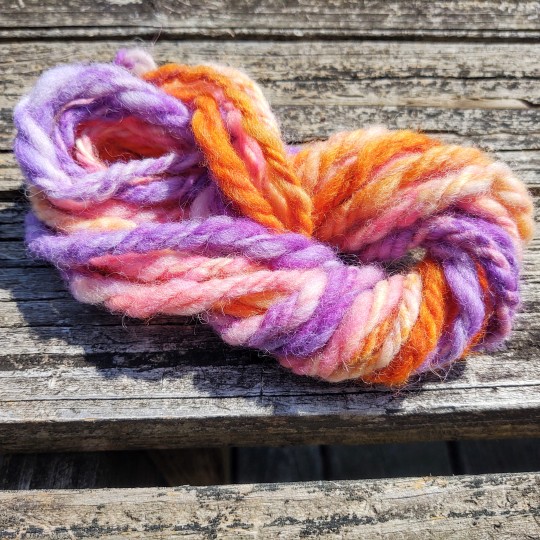
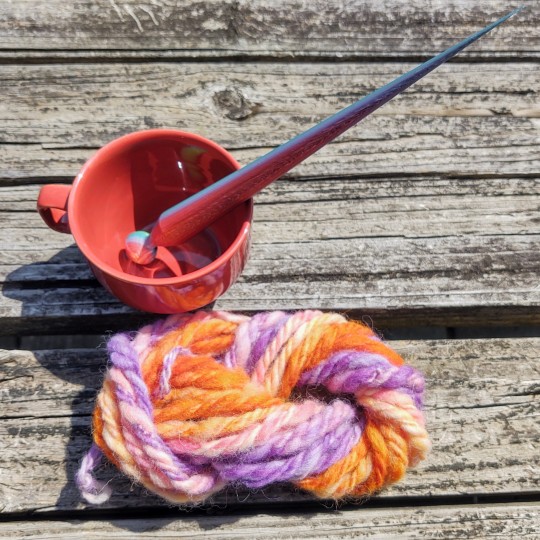
[ID: Three photos of a purple to pink to orange gradient yarn sitting on weathered wood planks in direct sunlight. In the first, the yarn is a single, unplied twist wrapped into a ball around a disc shaped core (the cardboard of an empty masking tape roll).
In the second, it is a loosely tied hank of three-ply yarn; it has been chain-plied, so neighboring segments of yarn are wrapped together, preserving the color change with minimal variegation.
The third photo features the hank laid with the opposite side up next to a shallow dark-orange mug with a spindle resting in it at a 40 degree angle. The spindle was 3D printed horizontally with a rainbow colored filament, from a spot of orange on one side through red, purple, blue, and to green on the other side. It is about nine and a half inches or twenty-four and a half centimeters long. The spindle is a supported Russian style, its base an inverted teardrop shape before a waist and the shaft of the spindle that's widest just above the waist and tapers down to as thin a spike at the top as possible. End ID]
I spun yarn! And plied it! This spindle and spinnable fluff were an incredibly generous gift from @dangerphd amid excess from 3D printing experiments! I'd previously spun one skein on a drop spindle in high school -- and I loved it for the process and made a chunky shawl of the Stephen West Spectra scarf design with it, but boy was it an uncontrolled thick and thin mess. Whether due to actually carrying over that learning more than a decade later, or the lighter (supported) spindle, or marginally more patience with age, this went way better!
I was definitely struggling with repeated breaks at the start and compromised my intention to go as thin as possible, but by the end I felt like I got decent control and consistency in my single's weight. And seeing how much less fragile those once-broken sock-weight singles are once plied should help me keep up the confidence with future fiber to really push for the thinner threads that I want to use. I had just learned about chain plying and wanted to try it when Danger sent the gradient fluff, so it wasn't a problem when there were several spots that I was sure would need plying for strength--and overall it's still less chunky than the thicker parts of the single I had made before! And much more even than I expected.
I haven't been brave and tried fulling it yet, just barely dampened and hung with a minor weight (a thick flannel shirt on its hanger) while drying. (It smells like wool once wet, though less strongly than some and I don't actually know its fiber contents.) But it's already pretty well behaved. It's a bit less than 20 feet of yarn, and I have to get into and through a different project right now, but I'll find something that lets me use it soon enough.
#thank you again dangerphd! it was such a cute package y'all#and it arrived while i was out for a very long day so it was like returning to a little dragon's horde of treasure in my mailbox#except a little more mad science themed than fantasy because 3D printing and spinning experiments#until i get some straw to become gold spun on the rainbow that is#spinning#fiber art#cj gladback#ramblings
43 notes
·
View notes
Text
Right now I'm listening to music and brushing out yarn until it fluffs. Why? I found out you can use acrylic yarn for needlefelting, all you need is a new wire bristle dog brush, acrylic yarn and an hour to kill. Sure I have real wool, but there's a lot of colors I'm missing and I’m not about to dye more colors in the middle of winter or lay down cash for individual colors which can get really pricey! Using acrylic yarn is not only cheaper but just easier to find, sometimes thrift stores give it away, and if you hoard yarn like I do, it’s pretty much a free resource, and a good way to use those tiny balls of yarn that aren’t good for any project. It’s also good for people who want to get into the hobby but are allergic to wool.
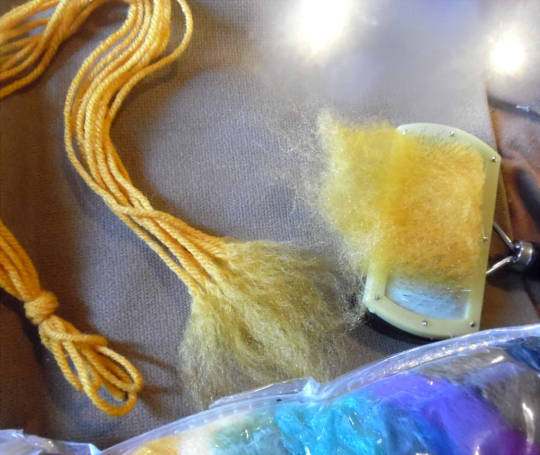
Acrylic ‘wool’ takes nothing to prepare, just wrap yarn of your choice about an arm’s length into a hank, wind a few times, tie a tight knot on the top, cut the ends evenly and brush from the ends up, a bit at a time. All the fibers that stick on the brush are your ‘wool’! Make as much as you want, mix different yarn colors, bundle up and store. The only downside is that it can’t be wet felted, due to the nature of it being acrylic, but the upside to that is you can take any leftovers and felt them together into a bracelet, pincushion, coaster, mug cozy, or drop them in a jar to use as detailing for future projects. So nothing really goes to waste!
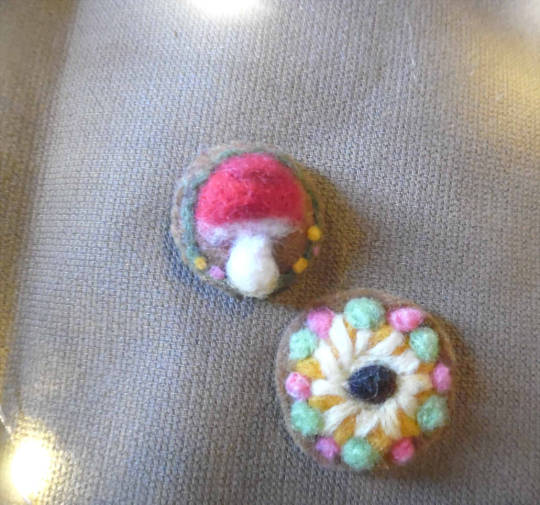
What about acrylic felt sheets from the craft store, can those be felted? Yes! Yes they can! While you can’t take them apart like yarn, they make a great base for flat felted pictures also known as felt painting. Here’s two button sized examples I made. They’re almost done, I just need to add pin backings to them.
But Chelly! What about the other equipment for needlefelting? Sadly you can’t use an alternative to the needles, but they’re relatively inexpensive anyways if you buy them in bulk. Last I checked you can get 30 of them for $10, just read the reviews first. The sponge mat under it can be expensive and wears away pretty fast. Good news though, you don���t need it. If you have tight weave burlap and a bag of rice handy, you can sew up a pillow as big or small as you like. Just double layer it, sew it, and pour in the rice til it becomes a flat pillow. Not only does it look super cottage aesthetic, it lasts longer than a sponge, and you can even add dried herbs like lavender or mint to the rice too, so every project you make will have that subtle scent. If you don’t have rice, polyfil will work too. Polyfil can also be needlefelted and makes a nice core for bigger felt projects, just don’t work it too much because it can get too dense.
To save your poor digits from getting pricked there’s some cheap alternatives out there. If you live in a place with a Dollar Tree it has silicone finger protectors in their craft aisle, but really most hot glue finger guards work too provided they’re thick enough. You can use metal thimbles, or you can make your own leather thimbles with old thick leather pieces.
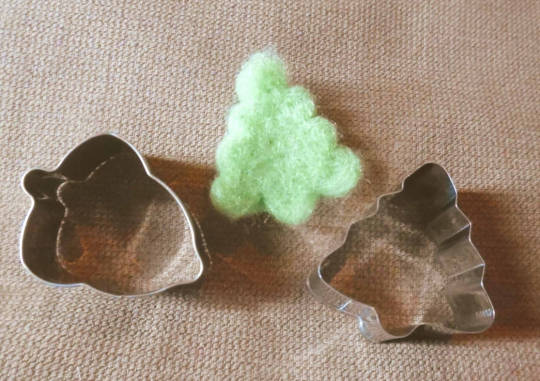
Oh, and did you know you can use cookie cutters as a template for making shapes? You do now. Happy felting!
46 notes
·
View notes
Note
Sar!!! you mentioned that in the sdv au tommy is a textile artist and also that wilbur adopted him... more tommy hcs?? (also maybe wilbur bc i love him and i know you do too :] )
THANK YOU FOR LETTING MY RAMBLE ABOUT TEXTILE ARE I LOVE IT SO MUCH JKFJKFSDJKNSFDNJKDSJKNFSDKJFDKDSFJKNGDSJKNS
S O
he started with sewing
makes sense ya know?
rowdy kid, hes gonna fucl up some clothes
so he teaches himself in the middle of the night to aviod a lecture on taking propper care of his belongings
and man loves it
something about the repetition and having to focus while zoning out on the same time really vibed with him
the only thing that can make him actually sit still for more than 10 minutes
then he learned how to embrioder
little designs on shirts and bags
HE EMBROIDERED A BEE ON TUBBOS SHIRT I AM S O F T
he was the one to make wilbur’s guitar strap <3
then came weaving!
looms are complex as heck (i had to build mine from a kit and it took like 2 hours jksfdkj) so he had to order it from the fancy desert town place
and warping takes a shit ton of time
so you could find him for hours walking back and forth warping his loom
(deadass a good warp can take 3-4 hours)
and in order to make cool tapestries he learns how to dye yarn and fabric!
also spinning yarn with the wool from ranboos sheep <3
(a basic drop spindle isnt too complex once you get it balanced and have clean roving to spin with)
and he makes decorations and shit!! very cool very pog
he prefers knit to crochet though he can do both
using two two needles is more fun than a hook
ya know?
so he makes a lot of clothes and pillows for him wilbur and tubbo
and it’s soft
and i love it so much :D
now wilbur <3
so in this au he just kinda found tommy and tubbo
and snatched the gremlin childred
man really said “mine <3″
his parents just kinda dipped the second he could take care of himself on his own rip
so he already knew how to cook and clean and all that jazz when he got the kids
his guitar strap is based on the l’manburg flag
l’manburg was basically a tree fort he had as a kid and he tells these wild stories about the adventurers about the “great general soot” and his “right hand men” as bedtime stories
also i am ignoring the heavier implications of his spiral because its my au and i want fluff please and thank you
(also i have to figure out how i want to integrate that into the story jkfsdjk)
his actual guitar was a gift from his parents before they left
and it means the fucking world to him
tommy once “stole” it as a prank and he had a breakdown
it’s the one thing he has left, ya know
mans got some unresolved trauma from that
so he taught himself the basics and went from there
all of his music is canon
all of it
every single song mr soot has ever wrote.
my au my canon
he plays in nikis cafe! both for extra cash and because he just loves to preform
thats all i got right now but i hope thats good :]
9 notes
·
View notes
Photo
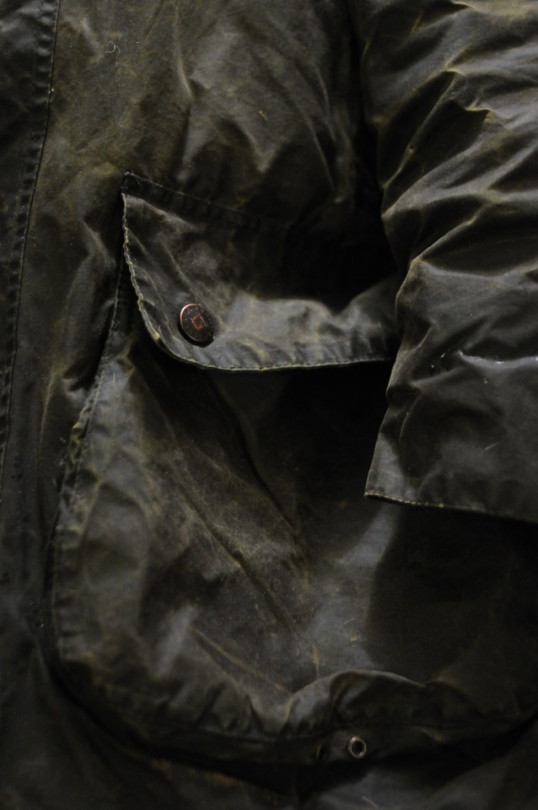
How to Clean Every Fall & Winter Fabric
At the heart of it, style this time of year comes down to fabrics. We love fall/ winter clothes for their hefty tweeds, waxed cottons, and soft flannel shirtings, but cleaning this time of year can be confusing. Can that parka be thrown into the wash? Does corduroy need to be dry cleaned? What are you supposed to do with that Barbour?
We reached out to the best cleaning expert we know of, Stu Bloom, the founder and President of Rave FabriCARE in Scottsdale, Arizona. Rave is unique in that they have their own in-house equipment. Whereas most cleaners send their work out to some mass cleaning plant, where jobs are treated indiscriminately, Rave sorts things according a garment’s design, fabric composition, and even stains. If anyone knows how to care for specific fabrics, it’s them.
Some important caveats before we proceed:
Know What Needs to be Dry Cleaned: If you have a water-based stain, such as those from sweat or coffee, you may be able to get those out at home in the wash. Oil-based stains, such as those from salad dressing or pizza, however, need to be taken to a professional dry cleaner. If you wash those at home, you'll likely set in the damage.
Consult Your Care Tags: This should be obvious. Even if something is made from cotton, there may be some internal construction that requires the garment to be dry cleaned. Always consult your care labels, but also supplement with a dose of good judgement and common sense. Stu estimates that 20% of the care labels he sees are inaccurate to some degree or another.
This is a List of Best Practices: Fall and winter clothes are often a bit rustic, meaning they draw from country traditions. And there’s something to be said about not babying a barn jacket. At the same time, we wanted to get a list of best practices. If you’ve just splurged on an expensive pair of well-tailored corduroy trousers, maybe you don’t want them looking like they’ve gone through the brush. The following is a list of cleaning practices for keeping clothes looking as new as possible.
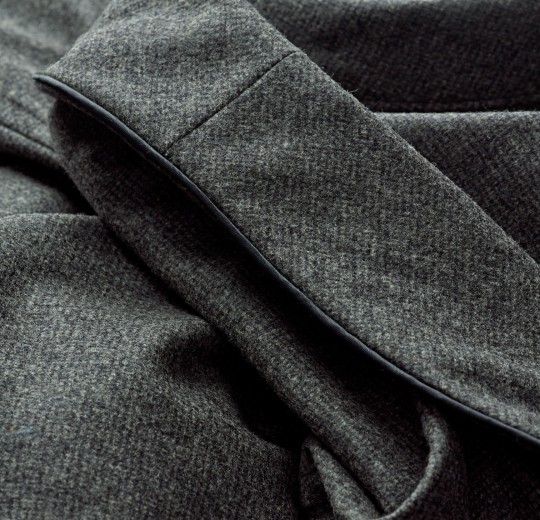
Wool (e.g. Flannel and Tweed): It should be obvious that tailored jackets -- such as suit jackets, sport coats, and dress outerwear -- ought to be dry cleaned. They often have complicated internal constructions, such as canvassing and shoulder padding, which can get wrecked in the wash. However, what to do about wool trousers and simpler outerwear?
Stu says wool trousers can be gently washed at home by hand, but the process is arduous. “Wool can shrink, which means you’ll want to take several measurements before washing, such as the waist, inseam, and outseam. After a gentle hand wash, you’ll want to hand block it back to those measurements and let it dry on its own.” Frankly, the process sounds like a pain, so we recommend just sending these out to dry cleaners. The same goes for simple wool outerwear, such as pea coats. “If there’s anything on this list that ought to be dry cleaned, it should be wool clothes,” says Stu.
For how to clean wool sweaters, we have a guide.
Waxed Cotton: Waxed cotton can be tricky, but the good news is that they don’t need to be cleaned often. For simple surface dirt, gently wipe the jacket with a wet sponge (don’t scrub or scour, as you can take off the wax coating). For heavier smells or water-based stains, you can soak them in the tub with some gentle detergent, then leave them to hang dry. For oil-based stains or an all out cleaning jobs, take them to a professional dry cleaner.
The problem with dry cleaning a waxed jacket, Stu notes, is that you’ll end up stripping off the wax. “Dry cleaning is an emulsifier of oils and that wax coating is oil,” Stu says. Which means, if you’re already taking off the wax, you may as well ask for both a wet and dry cleaning -- that way, you’ll have a completely pristine jacket. Afterwards, you’ll need to rewax the jacket. You can do this at home using materials Barbour sells, but the process can be arduous and messy. We suggest sending the job out to a specialist, such as New England Reproofers, or using a cleaner that has in-house capabilities, such as Rave FabriCARE.

Corduroy, Moleskin, and Chamois: Napped fabrics have small fibers standing up off the surface, which is what gives these materials their unique texture. Stu notes that, if not properly cared for, these fibers can get marred or distorted. The best way to care for corduroy, moleskin, or chamois is to hand wash them using lukewarm water and gentle detergent. Afterwards, leave the item to hang dry. Once it’s almost completely dry, throw it into the dryer to fluff up the nap (low heat or air dry only). Internal components, such as the waistband and pocket bags, can be ironed, but the rest should be steamed. “You never want to press a hot iron plate onto a napped fabric,” he says. “Otherwise, you’ll crush the nap.”
Cotton Canvas: Proper care for cotton canvas depends on how the garment was made. Clothes are colored by either dyeing the yarn or the garment itself. The first results in a more robust color, while the second has the color sitting just on the surface. Given the weight and texture of cotton canvas, if the garment is put through a washing machine, the color could rub off as the fabric beats against the agitator and drum.
Stu recommends hand washing cotton canvas, then hand drying afterwards. If that sounds like a pain, however, a front loading washing machine will always be better than a top loader. “They’re much gentler,” he says. “Front loaders lift up the garment and then drop them in the cycle, rather than beating them against the drum. If you can, you’ll also want to avoid heavy spin cycles and instead just letting the garment hang dry as much as possible.”
Cotton and Nylon Blends: Items such as mountain parkas and windbreakers are often constructed from of a 60/ 40 blend of cotton and nylon. The material is robust, which means care here is pretty easy -- just throw the item into the wash. Always be sure to hang dry afterwards, however. Stu notes that high heat can melt those nylon fibers.

Down: The warmest of material for winter needs special care. Down is made from the fine feathers sitting under the tougher exterior feathers on a bird. They’re the insulating layer, essentially. And on that down are small filaments sticking up, allowing them to interlock with each other. That’s what allows down to trap heat.
Those filaments are only able to stick up because of small oil particles, however, which means a down jacket should never be dry cleaned (no matter what the care label says). “Remember, dry cleaning is an emulsifier of oils,” says Stu. “The moment you strip off those oils, the filaments will collapse. This is something you’ll want to wet clean.” For those looking to do this at home, that means socking the item in a tub and hand washing it with some gentle detergent. Afterwards, run it through the dryer on the lowest heat setting possible. “It’s absolutely critical the down inside is completely dry before you wear or store the item,” Stu stresses. “Otherwise, you’ll end up with a smelly or lumpy mess.”
Note, this is for real down. Synthetic down can be either hand washed or dry cleaned. If you’re not sure which you own, just hand wash the item to be safe.
Wool and Cotton Blends: A particularly common combination for dress shirts and flannels, these blends can be safely thrown into the wash and hand ironed afterwards.
Red Plaid Shirts: Ever pull your laundry out from the wash and notice your whites have turned slightly pink? It’s the stuff of nightmares. If you’re worried about your red plaid shirts bleeding, compress a damp towel into your shirt. “Cheap shirts are sometimes made with cheap dyes,” says Stu. “You can test this before you wash by compressing a damp cotton towel into the inside of the shirt. If you see the color rub off, just wash it separately.”
You should also be following basic laundry practices. Light colored garments should be washed with other light colored garments, darks with darks. “There’s also something I call ‘mixed,’” says Stu. “That’s something like a burgundy and white striped shirt, or a black garment with a white design. If you’re not sure if something is light or dark, throw it in ‘mixed.’” What are red plaid shirts? “Those are your darks.”
There it is, how to take care of any fall or winter fabric you can possibly own. Again, these are the best practices for keeping something looking as new as possible. You may be safe going into the laundry room with some of these fabrics, but the point here is to use good common sense and some information about what problems may arise.
Big thanks to Stu for taking the time to talk with us!
103 notes
·
View notes
Text
Clothing knowledge: clothing accessories: details of the dispute, the taste is full.

Clothing is a project, including design and production, in which the production process is divided into various links, the most important part is the selection of materials, materials and fabrics, are divided into cloth and other accessories. we collectively refer to other accessories into clothing accessories, it is in addition to fabric clothing and clothing expansion of an essential part of the function.
Clothing accessories can be divided into seven categories according to their usage.
1.Garment lining
The material is used for clothing in the binder material, mainly cotton fabric, regenerated fiber fabric, synthetic fiber fabric, polyester cotton fabric, polyester taffeta, acetate fiber and viscose fiber blended fabric, silk fabric and rayon fabric.

The main test indexes of padding are shrinkage and color fastness. For the garment products with cashmere filling materials, fine or coated fabrics should be chosen to prevent the fleece from being laid off. At present, more use of chemical fiber as the main material lining silk.
What should be paid attention to when choosing clothing materials:
1, the performance of the material should be in line with the fabric properties. The performance here refers to shrinkage, heat resistance, washing resistance, strength and thickness, weight, etc., different materials have different performance characteristics.
2, the color of the material should be in harmony with the fabric, in general, the color should not be deeper than the fabric.
3, the material should be smooth, durable, anti pilling, and has good color fastness.

2.Clothing lining
Lining includes lining cloth and lining two kinds.
Interlining is mainly used for clothing collar, cuffs, bag, waist, cloak and suit skirt chest, usually containing hot melt coating, usually called adhesive lining.

According to the difference of base cloth, the fusible interlining is divided into spinning lining and non-woven lining. The woven fabric is woven or knitted fabric, and the bottom of the non-woven interlining is made of chemical fiber.
The quality of fusible interlining is directly related to the quality of ready-made clothing. Therefore, when choosing the fusible interlining, not only the appearance requirements, but also the parameters of the interlining, whether the performance is consistent with the quality requirements of the garment.
Such as: the heat shrinkage rate of interlining to try to coincide with the fabric should be sewing shrink; and cutting good; to bonding and fabric firmly under low temperature; high temperature to avoid pressing after the front face of the fabric permeability adhesive; adhesion durable, anti-aging washing.
On the liner includes a shoulder pad, pad, and bottoms with hip pad, thick texture is soft, not glue.

Attention should be paid to the selection of lining materials:
1, lining material should be matched with the performance of clothing fabric. Including lining color, unit weight, thickness, drape and so on. Such as flannel and heavy fabric lining should be thick, thin silk fabric and fabric with soft silk lining, knitted fabrics using elastic knitted interlining (Warp); bedding fabric color is pale; polyester fabric should not use cotton lining etc..
2, lining material should be matched with the function of different parts of clothing. A stiff collar and lining material used for lining the waist, thick coat lining use chest lining; handle of flat generally used for waist and cuffs garment skirt; lining stiffness and elastic should be used for neat crisp styling.
3, lining material should match with the service life of clothing. To wash clothing should choose washable lining, and considering the stability of lining material washing and ironing size; padding material, such as shoulder pads to consider conformal ability, to ensure that no deformation in a certain time.
4, lining materials should be matched with the production of clothing equipment. Professional and matching processing equipment, can give full play to the characteristics of cushion material auxiliary modeling. Therefore, when purchasing materials, combined with the working parameters of adhesion and processing equipment, targeted selection, can play a multiplier effect.
3.Clothing filling
Clothing filler, is placed between the fabric and the material between the warmth of the role of materials, according to the form of filling, can be divided into floc and wood two kinds.

1, Xu: no fixed shape, filling material is loose, clothing must be added inside (some even lining, and after receiving bile) or hand sewing machine. The main varieties of cotton, silk, wool and feather, and for heat insulation.

2, material: synthetic fiber or other synthetic materials processing flat warm filler varieties, such as polyester, acrylic type cotton, cotton and smooth plastic hollow. The utility model has the advantages of uniform thickness, easy processing and other anti mildew crisp, no insects, easy to wash.

4.Tape like materials
1. Wire materials
Mainly refers to the sewing line line materials and various materials with wire cord. Sewing line plays a role in sewing clothing pieces, connecting parts, also can play a certain role in decorative landscaping. Whether it is open or concealed, are part of the overall style of clothing. The most commonly used sewing thread is 60s/3 and 40s/2 polyester yarn, and the most commonly used embroidery line is rayon and silk yarn.

Process decorative line is also an important part of line materials. Decorative line into embroidery threads, according to the process can be roughly three kinds of knitting lines and mosaic line. Often used in clothing, bedding, furniture, fabrics, indoor supplies, restaurant supplies, etc..
In addition, there is a kind of decorative line, which is made for some special needs. It is called special line. It has a unique performance, the use of relatively small range, relatively high production costs, usually by the use of naming.

2, belt material
Mainly by the decorative belt, utility belt, industry belt and body composition of belt.

The decorative belt can be divided into: elastic belt, rib belt, cap wall belt, rayon lace, ribbon, belt and belt placket piping.
The utility of belt by nylon straps, belts, belt, etc. the kettle with a backpack.
The industrial zone by fire belt, electric belt and auto sealing belt; protective belt mainly refers to the bundle ring, shoulder waist knee etc..
Attention should be paid to the selection of clothing lines:
1, color and fabric should be consistent, in addition to decorative lines, should try to use the same color, and should be deep, not shallow.
2, should be consistent with the suture shrinkage of fabric, fabric after washing to avoid sewing stitch will not make the fabric wrinkle due to shrinkage is too large; and high elastic knitted fabric, elastic line should be used.
3, sewing thread thickness and fabric thickness, style appropriate.
4, suture materials should be close to the line with the fabric material properties, color fastness, elasticity, heat resistance and fabric suitable, especially garment dyeing products, sewing thread and fabric fiber components must be the same (special exception).

5.Closely linked materials
Closely linked materials such as buttons, zippers, hooks, rings and nylon buckles are used in clothing.

The following principles should be followed when choosing closely linked materials:
1, should consider the types of clothing, such as infants and children's clothing materials should be closely linked to simple and safe, generally use nylon zippers or hasps; men's and women's heavy focus on large, pay attention to the decoration of.
2, should consider the design and style of clothing, closely linked to the material should pay attention to the popularity, to achieve unity of decoration and function.
3, should consider the use and function of clothing, wind, raincoat, swimming equipment tightly linked material to be waterproof, and durable, should choose plastic products. Female underwear fastener to small and thin, light weight and strong pants zipper placket and skirt back to lock.
4, should consider clothing maintenance methods, as usual washing clothing should be less or no metal materials.
5, consider the clothing material, fastening materials such as heavy, fluff fabric application size, hook and loop and loop with loose structure for fabric.
6, should consider the location and clothing open form, such as clothing closely linked, no door, not button.
6.Decorative materials
There are many kinds of lace. Lace is also an indispensable part of decorative materials. It is an important decorative material for women's wear and children's wear, including woven lace and handmade lace.

Woven lace is divided into woven lace, embroidery lace and woven lace three categories; including handmade lace lace, lace, lace fabric yarn making lace, cotton lace, hand hook hand hook cotton clothes and other small women's accessories etc..

Clothing lace attaches importance to aesthetics, durability and washing. When choosing and applying lace, it is necessary to weigh the three characteristics of lace decoration, wearing and durability, and select them according to different demands.
Nowadays, our life is changing with each passing day, with the coming of personality era. In the era of the pursuit of fashion, many decorative materials have become the modern popular elements, such as hand nail beads, hand embroidered cotton flowers, hand series products, India silk badge, etc..



If you are interested,or want to learn more details information. You can actually get a better browsing experience by visiting our Official website:www.richpeace.com. Also you can send us emails or ask for our online consultation(www.richpeace.com ) to tell us about your needs and what functions you want to achieve,our engineers will give you the most professional answers. Richpeace can provide the 24 hours online consultation service. Richpeace Group have many series products with very competitive price for your choose. Please don't hesitate to contact with us in following ways:
E-mail:[email protected]
Skype:[email protected] Tel:0086-22-2253 0820
Fax:0086-22-2253 0820
2 notes
·
View notes
Text
Kirby’s Epic Yarn


“Sucked into a world made of cloth by the evil sorcerer Yin-Yarn, Kirby discovered he'd been turned into yarn! In this form, Kirby couldn't inhale or use Copy Abilities, but he gained new powers and could change his shape in amazing ways. With the help of Prince Fluff, the heroic prince of Patch Land, Kirby set out to defeat Yin-Yarn. Along the way, he helped the residents of Patch Land as a friendly neighbour in Apartment 101 of Dom Woole's apartment building!”
Kirby: Epic Yarn is a cutesy game that uses fabric designs for its characters and environments. The use of yarn and how it can change into different forms is extremely effective and how the side scroller levels are laid out almost like a homemade DIY tapestry. It manages to use craft materials, such as buttons and zippers to create interesting interactive environments. This relates to my work as I based some of my characters off the old yarn and ragdolls.
0 notes
Text
What to do when fabric pilling? Several ways to prevent pilling
What about fabric pilling? There are several methods for anti-pilling finishing, and there are many methods for anti-pilling. The methods before dyeing and dyeing are like changing the structure, composition and properties of the fiber, changing the spinning process and fabric structure of the yarn, changing the dyeing and finishing process, etc. However, we are generally used to finishing cloth and clothing after dyeing, the methods are: 1, bio-polishing (biological enzyme finishing) Bio-polishing is a process for improving the surface of cotton fabrics with cellulase to achieve long-lasting anti-pilling effect and increase the smoothness and softness of the fabric. Bio-polishing removes fine fibers protruding from the surface of the yarn, and the surface of the fabric has large fluff. Reduce, become smooth and not pilling. (The hydrolysis of the enzyme and the mechanical impact together remove the fluff and fiber ends of the fabric surface, making the fabric structure clearer and brighter.) The method is effective in reducing the pilling effect, because the tip of the fiber is removed rather than covered in the original place, but it should be noted that this method will have some loss of fabric strength and partial weight loss. For cotton and polyester/cellulosic fiber blend fabrics, cellulase is used; wool or polyester/wool blend fabric is polished with a suitable bio-protease. Therefore, the process conditions must be strictly controlled, otherwise the enzyme inactivation or serious damage, serious weight loss, and large-volume fabrics are not suitable (there are cylinder differences), so some knitted fabric dyeing and finishing factories are not willing to apply this method. 2, light fluffing method (mainly used for wool fabrics, such as sweaters, wool knitwear) After the knitwear such as sweater is lightly fluffed, the root of the wool fiber is felted in the yarn, and the fibers are entangled with each other, thereby enhancing the friction coefficient between the fibers, so that the fiber is not easy to be subjected to friction. The yarn is slid out, which in turn reduces the pilling of fabrics such as sweaters. At present, fabrics such as worsted sweaters are generally lightly fluffed to improve their anti-pilling effect. The process is: sweater infiltration - mild fluffing - cleaning - dehydration - drying. 3. Resin finishing method 1 principle Resin is a kind of polymer, which uses the function of resin to form a film on the surface of the fiber, so that the surface of the fiber is covered with a wear-resistant resin film, which makes the slip of the fiber weaken. At the same time, the tree refers to The evenly interlaced chain condenses on the surface layer of the yarn, so that the fiber end adheres to the yarn, and it is not easy to pilling when rubbed, thereby effectively improving the pilling resistance of the sweater. 2 resin selection The selected resin must have a large adhesion to the fiber, and it should also have a certain strength. It should have better elasticity and smooth and non-sticky feel after finishing. The adhesive film does not affect the color of the dye. Fastness and gloss. No irritation to human skin. No odor; tree refers to stable performance, convenient, reliable and low price. At present, the general resin (acrylic self-crosslinking type tree finger) can not meet the high requirements of customers for fabrics, because some anti-pilling agent (resin) has a hard feel after treatment, and the strength is lowered, and the processed object is colored. Some changes have occurred, and some resins must also be subjected to high temperature baking and the like. The foreign countries have gradually phased out and gradually developed a new generation of anti-pilling pilling agent. Its main products are polyurethane-based polymers and silicone resins. Now these products have been produced domestically and have been widely used in the production of knitwear. Anti-pilling finishing.
0 notes
Text
The Making of Strange Flower

Somehow I never showed my process of strange flower's creation. Below are the materials and steps.
Materials I used:
Yellow wool (mine was yellow yarn that I carded myself with a carding brush / pet brush)
Cheaper white core wool (mine was recycled fluffs from poly batting of my pandemic-era grocery delivery packing liners)
Glass pins for eyes
Air dry clay (mine was green paper clay and wood pulp clay but you can color air dry clay with some acrylic paint)
Wood glue (for water resistance), or PVA glue (if you don’t care for water resistence)
A good stick. I got mine from an old messed up artificial flower.
Felting needles
Felting base foam (I used recycled polyurethane packing foam blocks from my online orders)


To make a strange flower:
Start by felting the base of your flower’s face. You can speed up this process by wet-felting with soapy water mid way. It should end up looking like a concave cookie.
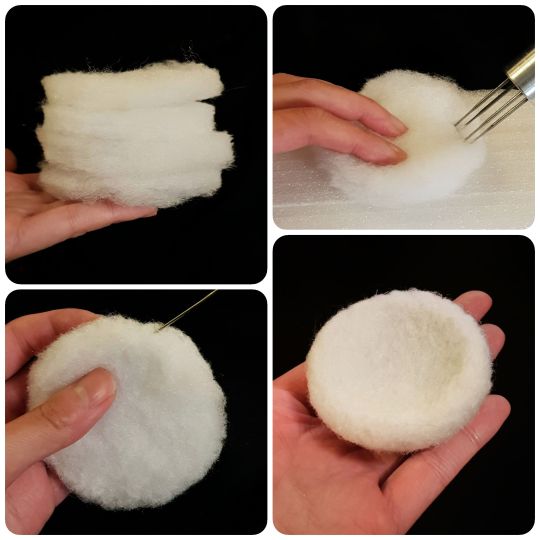
Then start to layer some yellow wool on top of your core wool cookie. Cover all the whites.

Then start to add details like cheeks, chin, and lips. You can test-place your flower’s eyes to better figure out the placement of your flower’s cheeks.
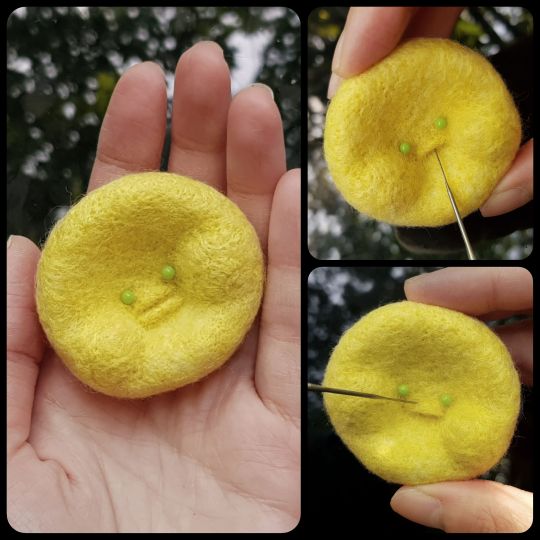
Then cut your glass pins short, bend the pin slightly downward (so it’s long enough to hold its position but won’t stick out the back of your flower’s head), and insert the beady eyes.

Start molding the desired flower petal shapes of your choice. I wanted mine to be plump. So I made it plump. Let it dry a bit. Then I added a water-down layer of wood glue and smooth out my clay petal. Poke a hole at the center of the petal about the size of the artificial stem.
Tip: If you’re also using an artificial flower stem, try to mold the base of your flower petal to fit into the stem head’s shape. Mine was a bit flat and ended up having a big gap and I had to use more glue to fill the void and it took ages to dry. Save any artificial petals you can salvage. Incorporate the ones that work with your strange flower. The rest can be materials for another project someday.
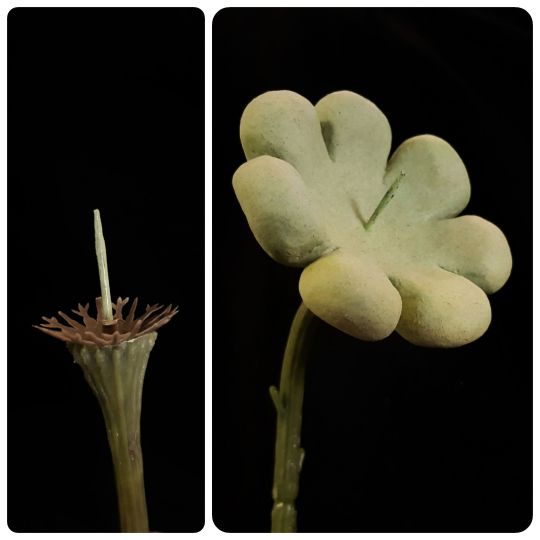
Once completely dry, pin your petals onto your artificial flower stem with some wood glue or PVA glue at its base.
Once the clay petal is dried and secured on the artificial flower stem, carefully poke your flower head on top.

And a strange flower is born! 🌷
#crafts#crafting#cute art#art#arts and crafts#upcycle#fiber art#springtime#flowers#flower#flowercore#bloomcore#tutorial#diy#weird friends#weirdcore#dreamcore#oddities#curio#creechur#fiber crafts#mixed media#sculpture#weird art#kidcore#prop design#puppetry#naturecore#nature art#botanical art
36 notes
·
View notes
Text
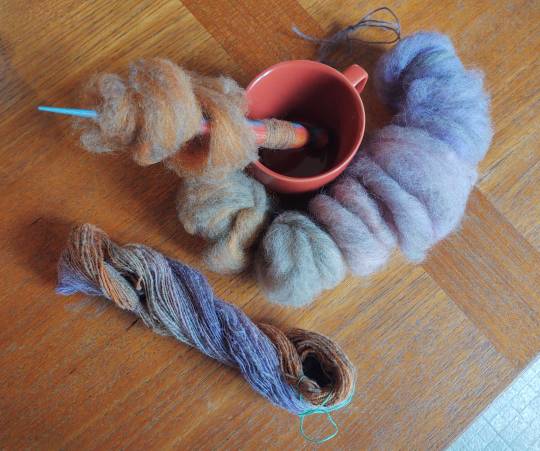
[ID: A photo of prepared wool fiber and wool yarn on a wooden tabletop. A multicolored spindle rests in an orange mug; orange and grey wool is in the process of being spun onto it, with a small amount wound onto the spindle's shaft as a fine single and the majority still wrapped loosely around the top as something like roving. Around the base of the mug lies a trail of more roving, wrapped into nests and threaded onto some yarn, all grey but with a gradient of colors mixed in. In order: lighter orange, pale peach, rose pink, purplish pink, light purple, and medium purple. On the table next to the garland is a small skein of sock yarn spun from the same gradient, somewhat overplied and tied with a length of bright mint green yarn. End ID]
One down, most of one to go! I executed my plot: carded up bonus thrift store lanolin wool, reclaimed the gradient fiber from my first support-spindle-spun skein and carded it into seven gradient steps, blended those two fibers together, and divided the whole progression into two equal sequences for socks or mitts or...something. I've heard of spinners working hard to avoid muddying up their fiber colors, meanwhile I'm over here splashing in the mud puddles! The above photo was taken in the overcast afternoon light from our kitchen windows, so it's even more grey, but as a reminder this is what the colorful half of this looked like in its previous form:
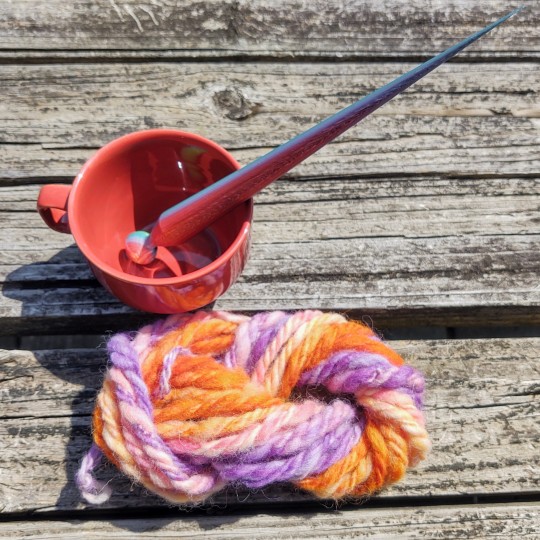
[ID: The same spindle in the same orange mug, this time on weathered wood in direct sunlight with a very chunky skein of safety-vest-orange yarn fading to pale orange and pink with white patches and finally a bright purple. End ID]
I'll be honest I did have some second thoughts about blending once I'd re-carded the yarn into a smoother gradient. But I know I don't use small amounts of yarn well, especially in bright colors, and the fiber did feel a bit frazzled by the time it had no strings remaining. It benefited a lot from combining with the too-much-lanolin of its grey friend. So on to join my trusty cone of dark grey wool in some more staid applications! I am really happy with the tweedy look of this first skein, not removing any neps that had spinnable fuzz still attached (and tbh probably leaving a few slubs that could've been teased out in drafting if I hadn't spun a section of this on the bus to and from IMTS in the pitch dark of pre-dawn and late night). Only concern now is that I did just pull out the cone and realize it's only about 22wpi and my first skein is closer to 30wpi. Maybe it'll fluff up in washing? But either way I think I'll be likely to sacrifice symmetry in favor of fewer frustrations with snapping yarn while chain plying and let my second single trend a little heavier than "as thin as possible." I think the lanolin has helped a bit with it sticking together longer but it's not magic.
#cj gladback#spinning#fiber art#ramblings#I still haven't tried actually spinning on the e-spinner that was packed with the grey wool#the spindle is just so portable! can be done on lap while watching tv or laptop equivalent#no wheel or e-spinner is gonna fit in my purse for sanity keeping on a semi-spontaneous trip to a trade show#(though if i worked for one of the manufacturers and could demonstrate their parts in service#in a briefcase wheel it would be my favorite event of the year)#and it's such a low-commitment thing to start and stop when waiting on anything#with this wool (and maybe I should feel the same about others) i do want to wash my hands after spinning#but that's possibly more the thrift store element than the unscoured fleece -- dog hair and occasional gritty debris#for more than just the confirmation of how much I've overplied and its final texture i'm looking forward to washing this
7 notes
·
View notes
Text
you can thread it in and out of the the need for stitches
How you can Rewrite Wool By Doggie Hair. If you ever own a longhaired dog, you may have marveled for the copious amounts of fluff dogs shed for the duration of grooming. If you knit, crochet or interweave, you can harvest this fur to angle yarn for your crafts. The undercoat with dogs produces a luxurious fiber called chiengora in the knitting world. Now you can wear very good fur humanely obtained from the host pet animal, at little or no cost. Save clean, chemical-free hair from a suitable breed. The dog's hair must be 2 inches or for a longer time if you wish to create yarn without blending many other long fibers, such <a href="http://www.myhairon.com/lace-closure/silk-base-closure/">silk closures</a> as wool. Keep the very soft undercoat for spinning, and discard the exact stiff, scratchy outer hairs. Card your new puppy hair with two slicker brushes or simply cotton carders. Carding disentangles the hair is from each other so they're easier to support. Draw one brush through the other typically until the hairs fluff up. Take a a few carded hair in one hand and bring some hairs from the mass with your absolutely free hand. Twist and pull gently right until yarn <a href="http://www.myhairon.com/hair-extensions/clip-in-hair/">clip in hair extensions</a> begins to form. Take care to keep out of pulling the yarn from the mass. Will spin by attaching some dog wild hair from your carded mass to the fluffed conclude of the yarn on the spindle. Turn the exact spindle clockwise, and let the dog hair huge twist and join up with the yarn in the spindle. A hair net does the effective task of keeping your hair out of the way, but may add vintage flair to your look or simply meet religious requirements. Rather than buying wild hair nets, crochet your own and customize it to the size of your head and amount of hair you might want to cover. You can also customize each hair world-wide-web for color, coordinating them to your wardrobe. Crochet the hair band <a href="http://www.myhairon.com/lace-wigs/full-lace-wigs/">full lace wigs</a> using one 2x crochet in each of the <a href="http://www.myhairon.com/brazilian-hair/">human hair weave</a> stitches around. Minimize and fasten your yarn. Weave the tip into your work. If you decided to use accommodating, you can thread it in and out of the the need for stitches, then sew the ends together with a stitching filling device and even carefully thread.
0 notes
Text
then sew the ends together with a stitching filling device and even line
The way to Spin Yarn Via Dog Hair. In case you own a longhaired dog, you may have marveled in the copious amounts of fluff dogs shed throughout grooming. If you knit, crochet or integration, you can harvest this fur to rewrite yarn for your crafts. The undercoat associated with dogs produces a luxurious fiber called chiengora in the knitting world. Now you can wear good fur humanely obtained from the host pet, at little or no cost. Save clean, chemical-free hair from a suitable breed. The dog's hair must be 2 inches or lengthier if you wish to create yarn without blending some other long fibers, such as wool. Keep the smooth undercoat for spinning, and discard the actual stiff, scratchy outer hairs. Card your dog hair with two slicker brushes or simply cotton carders. Carding disentangles the hair is from each other so they're easier to support. Draw one brush through the other typically until the hairs fluff up. Take a bit of carded hair in one hand and bring some hairs from the mass with your absolutely free hand. Twist and pull gently right until yarn begins to form. Take care to keep out of pulling the yarn from the mass. Will spin <a href="http://www.myhairon.com/hair-extensions/clip-in-hair/">clip in hair extensions</a> by attaching some dog wild hair from your carded mass to the fluffed conclude of the yarn on the spindle. Turn the exact spindle clockwise, and let the dog hair huge twist and join up with the yarn in the spindle. A hair net does the effective task of keeping your hair out of the way, but may add vintage flair to your look or simply meet religious requirements. Rather <a href="http://www.myhairon.com/brazilian-hair/">hair weave</a> than buying wild hair nets, crochet your own and customize it to the size of your head and amount of hair you might want to cover. You can also customize each hair world-wide-web for color, coordinating them to your wardrobe. Crochet the hair band <a href="http://www.myhairon.com/lace-closure/silk-base-closure/">silk closures</a> using one 2x <a href="http://www.myhairon.com/brazilian-hair/">human hair weave</a> crochet in each of the stitches around. Minimize and fasten your yarn. Weave the tip into your work. If you decided to use accommodating, you can thread it in and out of the joins, then sew the ends together with a stitching filling device and even line.
0 notes
Text
Keep the tender undercoat for spinning
The best way to Rewrite Wool By Doggie Hair. If you happen to own a longhaired dog, you may have marveled along <a href="http://www.myhairon.com/hair-extensions/clip-in-hair/">clip on hair extensions</a> at the copious amounts of fluff dogs shed in grooming. If you knit, crochet or interweave, you can harvest this fur to spun yarn for your crafts. The undercoat for dogs produces a luxurious fiber called chiengora in the knitting world. Now you can wear high-quality fur humanely obtained from the host cat, at little or no cost. Save clean, chemical-free hair from a suitable breed. The dog's hair must be 2 inches or much longer if you wish to create yarn without blending various other long fibers, such as wool. Keep the tender undercoat for spinning, and discard typically the stiff, scratchy outer hairs. Card your pet hair with two slicker brushes or maybe cotton carders. Carding disentangles the hair from each other so they're easier to help with. Draw one brush through the other regularly until the hairs fluff up. Take a tiny amount of carded hair in one hand and sketch some hairs from the mass with your cost-free hand. Twist and pull gently until eventually yarn begins to form. Take care to keep via pulling the yarn from the mass. <a href="http://www.myhairon.com/brazilian-hair/">brazillian hair</a> Commence to spin by attaching some dog frizzy hair from your carded mass to the fluffed conclusion of the yarn on the spindle. Turn typically the spindle clockwise, and let the dog hair muscle size twist and join up with the yarn about the spindle. A hair net does the practical task of keeping your hair out of the way, but could also add vintage flair to your look or maybe meet religious requirements. Rather than buying frizzy hair nets, crochet your own and customize them how <a href="http://www.myhairon.com/hair-extensions/peruvian-hair/">peruvian hair</a> to the size of your head and amount of hair it is advisable to cover. You can also customize each hair online for color, coordinating them to your apparel. Crochet the hair band using one two times <a href="http://www.myhairon.com/lace-closure/silk-base-closure/">silk base closure</a> crochet in each of the stitches around. Trim and fasten your yarn. Weave the conclusion into your work. If you decided to use supple, you can thread it in and out of the appears, then sew the ends together with a sewing hook as well as twine.
0 notes